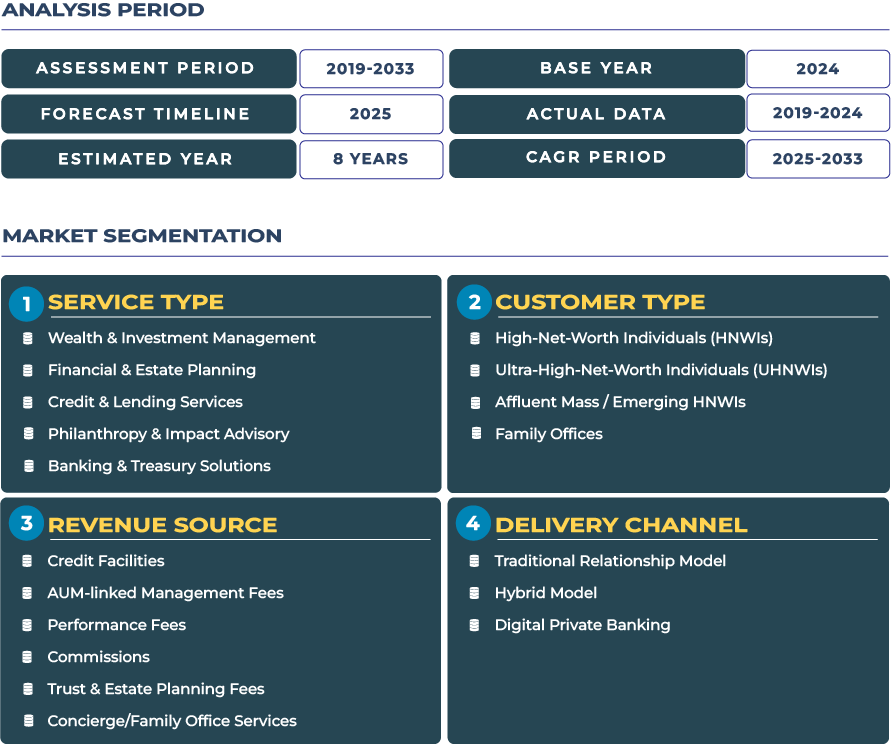Colombia’s Entrepreneurial Wealth and Digital Adoption Redefine the Private Banking Landscape
Colombia private banking market is undergoing a transformative phase driven by a surge in entrepreneurial wealth and rapid digital integration across financial services. As the country’s start-up ecosystem matures and small-to-medium enterprise owners accumulate wealth, local banks are reconfiguring their offerings to capture the expanding affluent segment. The private banking market in Colombia is projected to grow from USD 8.8 billion in 2025 to USD 13.3 billion by 2033, registering a CAGR of 5.4% during 2025–2033, according to DataCube Research. This growth reflects how structural reforms, energy diversification, and urban affluence are reshaping wealth management in Latin America’s fourth-largest economy.
The trend underscores a growing appetite for sophisticated wealth and investment management solutions, estate planning strategies, and digital lending tools that cater to Colombia’s evolving investor class. Institutions are focusing on building digital trust and personalization—qualities that define the modern private banking ecosystem—while aligning with government initiatives for financial inclusion led by the Superintendencia Financiera de Colombia.
Note:* The market size refers to the total revenue generated by banks through various services.
Market Outlook: Colombia Private Banking Momentum Fueled by Entrepreneurial and Digital Synergies
Colombia private banking market is benefitting from a confluence of entrepreneurial activity, expanding energy wealth, and progressive digital transformation. The rise of technology-driven enterprises in cities such as Bogotá, Medellín, and Cali has created a new generation of high-net-worth individuals (HNWIs) seeking customized portfolio management, business succession planning, and structured credit solutions. Financial institutions are integrating next-generation advisory models—leveraging analytics, secure digital onboarding, and virtual consultations—to enhance client experience and trust in wealth advisory relationships.
Meanwhile, strong macroeconomic stability and proactive regulation have reinforced Colombia’s financial credibility in the region. The Banco de la República continues to pursue monetary discipline amid external shocks and inflationary pressure, maintaining investor confidence in the financial system. As a result, Colombia private banking sector is expected to continue attracting offshore investors and local entrepreneurs seeking diversified capital preservation and growth options through hybrid asset allocations and sustainable investment strategies.
Drivers & Restraints: Balancing Energy Wealth, Urban Affluence, and Market Uncertainty
Energy Wealth and Financial Modernization Accelerate Affluent Market Expansion
Colombia’s vast natural resources and the diversification of its energy exports have historically underpinned wealth creation, particularly in oil, gas, and renewable energy sectors. The growing participation of private investors in energy transition funds and infrastructure projects has driven new opportunities for private banks to offer tailored advisory services. Urban affluence, led by cities such as Bogotá and Medellín, continues to fuel demand for customized investment management and credit solutions. Digital transformation across banking services further reinforces modernization, with institutions adopting advanced client engagement platforms and automation to increase operational efficiency.
Security Risks, Inequality, and FX Volatility Restrain Market Depth
Despite its growth trajectory, Colombia’s private banking industry faces structural challenges. Persistent income inequality and sporadic security risks in certain regions limit the expansion of affluent segments. Moreover, foreign exchange volatility continues to affect cross-border investment flows and portfolio diversification. Political shifts and regulatory uncertainties can occasionally disrupt investor confidence, although the Asociación Bancaria y de Entidades Financieras de Colombia (Asobancaria) remains instrumental in ensuring financial system stability through industry coordination and regulatory advocacy. For sustained growth, banks must enhance resilience through risk-adjusted strategies, currency hedging services, and transparent digital communication.
Trends & Opportunities: ESG Integration and Digital Private Banking Gain Momentum
Digital Wealth Services and Family-Office Evolution Drive Structural Change
Colombia’s affluent clients are rapidly embracing digital wealth platforms, prompting banks to reimagine private advisory frameworks. Hybrid advisory models—combining human expertise with secure digital interfaces—are enabling institutions to deliver data-driven portfolio insights and seamless client engagement. Family-office setups are gaining traction among ultra-high-net-worth clients, focusing on long-term estate planning, generational wealth transfer, and alternative investments. This trend signals a broader evolution toward institutional-grade governance and financial stewardship within Colombia’s private banking landscape.
Energy Transition Funds and Fintech Partnerships Define Emerging Opportunities
Amid the global transition toward renewable energy, Colombian private banks are launching ESG-linked investment products aligned with sustainable mining, green energy, and social impact sectors. These offerings appeal to both domestic and offshore investors seeking long-term environmental and financial returns. The country’s fintech ecosystem, supported by innovation-friendly regulation, is fostering new partnerships between traditional banks and digital wealth platforms. Such alliances are catalyzing new product innovations across digital lending, portfolio analytics, and philanthropy advisory, allowing banks to expand their service portfolios and appeal to a tech-savvy clientele.
Competitive Landscape: Domestic Strength and Global Collaborations Shape the Market
Colombia private banking ecosystem is characterized by the coexistence of strong local institutions and selective global entrants. Leading financial entities such as Bancolombia, Grupo Aval, and Banco de Bogotá continue to dominate the domestic high-net-worth client base through tailored wealth solutions and international partnerships. In 2024, Bancolombia expanded its private banking offering by integrating ESG-focused investment funds and digital wealth tools for affluent clients in the Andean region. Similarly, Grupo Aval’s wealth management arm has enhanced cross-border advisory services to cater to Colombian expatriates and regional investors.
International banks, including Spain’s BBVA and Switzerland’s UBS, are also reinforcing their presence through alliances with local asset managers, aiming to capture Colombia’s growing HNWI segment. The strategic shift toward sustainable portfolios, client education, and technological integration underscores how competition in Colombia’s private banking sector is moving beyond traditional asset growth toward client experience, transparency, and impact-driven investment philosophy.







